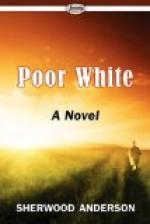|
This section contains 6,513 words (approx. 22 pages at 300 words per page) |

|
SOURCE: Enniss, Stephen C. “Alienation and Affirmation: The Divided Self in Sherwood Anderson's Poor White.” South Atlantic Review 55, no. 2 (May 1990): 85-99.
In the following essay, Enniss analyzes the notion of escape and, for Anderson, its consequent affirmation of self and community, in Poor White.
It has become a critical cliché that Sherwood Anderson was a writer who tried to retell in his novels and stories his own mythic escape from his Elyria paint factory.1 In his first novel (Windy McPherson's Son, 1916) Sam McPherson leaves behind wealth and position in order to wander the countryside working as a common laborer. Like Anderson himself, John Webster (Many Marriages, 1923) gets up from his desk and walks away from his washing machine business and his family, while John Stockton (Dark Laughter, 1925) runs away to the South and takes the name Bruce Dudley. In the stories of these lives, Anderson expresses something of...
|
This section contains 6,513 words (approx. 22 pages at 300 words per page) |

|


